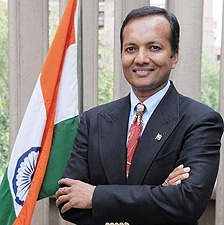It doesn’t get anymore official than this!

One Man’s Fight For The Right To Display Our Tiranga Leads to a Historic Change In Our Flag Code
Prior to 2002, the general public of India could not fly their National flag publicly except on designated national holidays. Only government offices and higher functionaries of the government could do so.
An industrialist by the name, Naveen Jindal filed a Public interest petition in the Delhi High Court, seeking the striking down of this restriction. Jindal apparently flew the flag atop his office building, but as this was against the then national flag code, the flag was confiscated and he was informed that he was liable to be prosecuted. Jindal argued that hoisting the National flag with due decorum and honour was his right as a citizen, and a way of expressing his love for India.

“The Indian flag does not just belong to the government or the bureaucracy, it belongs to every Indian,” said Jindal.
He knew he had only two options, either to meekly comply or fight for his right in a court of law. He chose the latter. The case moved to the Supreme Court of India, which asked the Government of India to set up a committee to consider the matter. The Union Cabinet finally amended the Indian flag code with effect from 26 January 2002, allowing the general public to hoist the flag on all days of the year, provided they safeguarded the dignity, honour and respect of the flag.
Today, Mr. Naveen Jindal (MP) from the Kurukshetra Lok Sabha constituency, is also the chairman of Jindal Steel & Power Ltd. and founder of the Flag Foundation of India, a unique and committed NGO, that spawns awareness for our Tiranga amongst Indian citizens, and encourages them to fly it regularly. His efforts over the years to promote the use of our national flag is truly commendable and is applauded by every Indian.
The Flag Code Of India
The Indian National Flag represents the hopes and aspirations of the people of India. It is the symbol of our national pride. Over the last five decades, several people including members of armed forces have ungrudgingly laid down their lives to keep the tricolour flying in its full glory.
The significance of the colours and the chakra in the National Flag was amply described by Dr. S. Radhakrishnan in the Constituent Assembly which unanimously adopted the National Flag. Dr. S. Radhakrishnan explained – “Bhagwa or the saffron colour denotes renunciation of disinterestedness. Our leaders must be indifferent to material gains and dedicate themselves to their work. The white in the centre is light, the path of truth to guide our conduct. The green shows our relation to soil, our relation to the plant life here on which all other life depends. The Ashoka Wheel in the center of the white is the wheel of the law of dharma. Truth or satya, dharma or virtue ought to be the controlling principles of those who work under this flag. Again, the wheel denotes motion. There is death in stagnation. There is life in movement. India should no more resist change, it must move and go forward. The wheel represents the dynamism of a peaceful change.”
There is universal affection and respect for, and loyalty to, the National Flag. Yet, a perceptible lack of awareness is often noticed, not only amongst people but also in the organisations/agencies of the government, in regard to laws, practices and conventions that apply to the display of the National Flag. Apart from non-statutory instructions issued by the Government from time to time, display of the National Flag is governed by the provisions of the Emblems and Names (Prevention of Improper Use) Act, 1950 (No. 12 of 1950) and the Prevention of Insults to National Honour Act, 1971 (No. 69 of 1971). Flag Code of India, 2002 is an attempt to bring together all such laws, conventions, practices and instructions for the guidance and benefit of all concerned.
For the sake of convenience, Flag Code of India, 2002, has been divided into three parts. Part I of the Code contains general description of the National Flag. Part II of the Code is devoted to the display of the National Flag by members of public, private organizations, educational institutions, etc. Part III of the Code relates to display of the National Flag by Central and State governments and their organisations and agencies. Flag Code of India, 2002, takes effect from January 26, 2002 and supersedes the ‘Flag Code-India’ as it existed.
